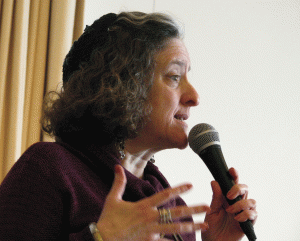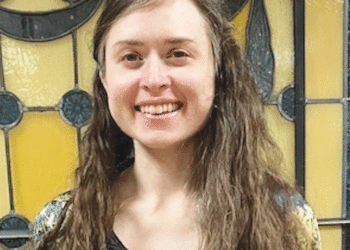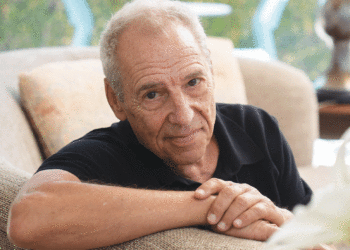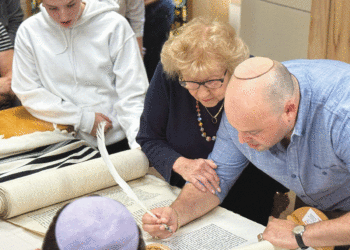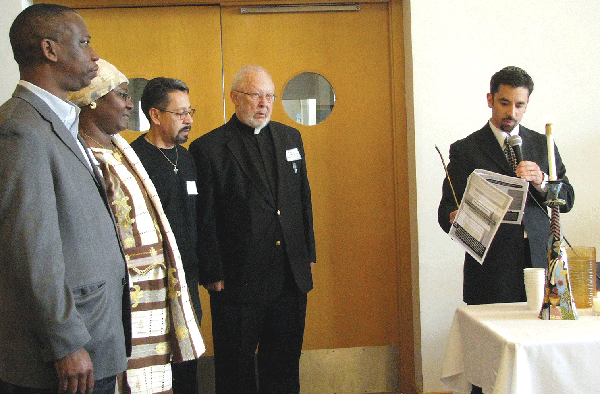 Participating in a candle lighting ceremony at Jewish Community Action’s 7th Annual Immigrant Rights Freedom Seder on Sunday at Mount Zion Temple in St. Paul were (l to r): Kerper Dwanyen, president of the Organization of Liberians in Minnesota; Mayalan Keitu Brown; Paul Rael, St. Bridget Catholic Church Hispanic Ministries, Postville, Iowa; Father Paul Ouderkirk, St. Bridget Catholic Church; and Rabbi Adam Stock-Spilker, Mount Zion Temple. The Haggada used for the Freedom Seder extended the Jewish liberation story in Exodus to contemporary struggles on behalf of justice for immigrants, Latinos, Liberians and others. (Photo: Mordecai Specktor)
Participating in a candle lighting ceremony at Jewish Community Action’s 7th Annual Immigrant Rights Freedom Seder on Sunday at Mount Zion Temple in St. Paul were (l to r): Kerper Dwanyen, president of the Organization of Liberians in Minnesota; Mayalan Keitu Brown; Paul Rael, St. Bridget Catholic Church Hispanic Ministries, Postville, Iowa; Father Paul Ouderkirk, St. Bridget Catholic Church; and Rabbi Adam Stock-Spilker, Mount Zion Temple. The Haggada used for the Freedom Seder extended the Jewish liberation story in Exodus to contemporary struggles on behalf of justice for immigrants, Latinos, Liberians and others. (Photo: Mordecai Specktor)Â Â Â Â Â Â
By AMY KLEIN
LOS ANGELES (JTA) — On April 5, 1968, Arthur Waskow was walking to his house in Washington, D.C., among rioters and armed guards. It was a neighborhood under curfew, the night after the Rev. Martin Luther King Jr. was killed.
Waskow, who had been involved in the civil rights movement, spent the week ferrying food, medical supplies and doctors from the white neighborhoods to the black neighborhoods. The next week was Passover.
“I was walking home past the army and my kishkes began to say, ‘This is Pharaoh’s army,’” recalled Waskow, now a rabbi.
Back then he was hardly a practicing Jew, and that night, for the first time, he really thought about what freedom meant at the Passover seder.
“I found myself profoundly moved that this discussion of liberation didn’t only apply 3,000 years ago to ancient Israelis but to other generations as well,” he said.
Frightened and inspired, Waskow went on to write a new version of the Haggada using passages from King, Henry David Thoreau, Allen Ginsberg, slave owners and Warsaw ghetto literature, combining it with the traditional Haggada — his own tattered Bar Mitzva copy.
The next year, on April 4, 1969 — the anniversary of King’s assassination — he used it at his first “Freedom Seder,” where some 800 people — blacks and whites, Jews and non-Jews — gathered to celebrate freedom on Passover.
“That night changed my life,” Waskow said.
It changed the lives of many others, too — albeit indirectly — because it opened up the seder to modern-day causes.
While it has become common at seders today to tie Passover’s freedom from slavery theme to contemporary issues — feminism, homosexuality, war, the economy, the environment — the original Freedom Seder in Washington and its Haggada spawned generations of nontraditional seders in which the Egyptians serve only as a metaphor for what enslaves the Jews.
“Every Haggada before that one had told the story of the liberation of the ancient Israelites from slavery under Pharaoh — period,” Waskow said.
By weaving the Jewish story with the struggles for freedom of black America and other cultures, races and religions, “it has sparked for many people the creation of many seders and Haggadot devoted to various aspects of liberation,” he says.
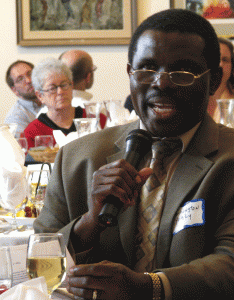 Speaking at the Freedom Seder, Washington Yonly, a leader of the Organization of Liberians in Minnesota, expressed appreciation for the decision announced by the Obama administration last week to extend the Deferred Enforced Departure (DED) status of Liberian refugees in the U.S. for 12 months, which is a reprieve from imminent deportation. (Photo: Mordecai Specktor)
Speaking at the Freedom Seder, Washington Yonly, a leader of the Organization of Liberians in Minnesota, expressed appreciation for the decision announced by the Obama administration last week to extend the Deferred Enforced Departure (DED) status of Liberian refugees in the U.S. for 12 months, which is a reprieve from imminent deportation. (Photo: Mordecai Specktor)
Â
On March 29, 40 years later — 40 being significant as the Jewish number symbolizing rebirth — Waskow’s Shalom Center, a Reconstructionist activist organization, is sponsoring a new Freedom Seder for the Earth in Washington at the Shiloh Baptist Church.
Like the original Freedom Seder it will be interfaith, multiracial, multicultural and rooted in the ancient Passover. But instead of slavery, it will highlight what Waskow calls “climate catastrophe.”
Like the 10 plagues that destroyed Egypt and its ecology, the environment now suffers many dangers, such as global warming — or “scorching,” according to Waskow — drought and hunger. Other groups across the country will hold Freedom Seders for the Earth and use the new Haggada, Freedom Seder for the Earth: Facing the Plagues and the Pharaohs of Our Generation, or they may just use the new Haggada.
For example, karpas, the seder tradition of dipping a vegetable or sprig in salt water to signify the salty tears of slavery, begins in the Freedom Seder with this prayer: “If we cannot take joy in the return of spring, how can we be happy in utopia? The Song of Songs brings us the springtime when flowers rise up against winter, the juices of love arise from the depths of depression, and the night-time of history gives way to the sunlight of Eden, the garden of delight.”
Yachatz, the seder ritual of breaking the matzo, begins with this prayer: “Why do we break this bread in two? Because if we hold on to the whole loaf for ourselves, it remains the bread of oppression. If we break it in order to share it, it becomes the bread of freedom. In the world today, there are still some who are so pressed-down that they have not even this bread of oppression to eat. There are so many who are hungry that they cannot all come and eat with us tonight.”
Hunger is another contemporary issue being raised at seders today.
Many modern-day causes that organizations are promoting for Passover — such as the Jewish World Watch’s awareness-raising about Darfur, the Jews United for Justice Labor Seder for D.C.’s day laborers and the Hebrew Immigrant Aid Society’s “Progress by Pesach,” a national Jewish campaign promoting humanitarian immigration reform — hunger especially in this economic climate needs urgent attention.
That’s why the Jewish Council for Public Affairs, the national public affairs arm of the organized Jewish community, is co-sponsoring the Child Nutrition Seder with Mazon, a national nonprofit Jewish agency that fights hunger.
The seders, which are being held April 1-8 at more than 20 locations across the United States, are timed to raise awareness of the child nutrition reauthorization bill in the U.S. Congress that funds the federal government antihunger programs and is being drafted now in the House of Representatives and the Senate.

Rabbi Amy Eilberg (above) led Sunday’s Immigrant Rights Freedom Seder at Mount Zion, along with Rabbi Adam Stock Spilker. The Haggada, which Eilberg read from at times, notes that the Exodus story is shared by all people who are “struggling to hold on to who they are while emigrating to make a better life. Tonight, as we share this liberation story of the past we will hear from community members here with us this evening who are involved in a liberation struggle of today, that of immigrants in the United States.” The liturgy also acknowledges and honors the “First Nations people who lived here first, and have struggled against oppression to maintain their culture and way of life,” and African Americans who were “brought here against their will, many in chains,” and organized to gain their freedom. (Photo: Mordecai Specktor)
Organizers of the Child Nutrition Seder hope that participants will lobby their representatives, who will vote on the bill after congressional recess ends April 20.“President Obama pledged to end childhood hunger by 2015,” said Hadar Susskind, the Washington director of the JCPA. “We’re having these seders to get the Jewish community and the faith community to push for robust programs.”
Out of 34 million Americans who are “food insecure,” as the JCPA calls them, 12 million are children — and these figures are before the results of the current economic crisis are known.
“Passover is such a good vehicle because slavery is a metaphor for a lot of different things, like the slavery and the servitude of hunger,” Susskind said. “People can’t be free if they don’t have food.”
The Child Nutrition Haggada, Let All Who Are Hungry Come and Eat: A Seder Dedicated to Child Nutrition and Hunger Awareness, includes things such as the four cups of wine for effective activism in eradicating hunger (Education/Awareness; Make it Personal; Advocate; Organize) and the halach ma’anya, the traditional Bread of Poverty prayer, followed by the Mazon Passover Reflection:
“One day, God, may it be Your will that we live in a world
perfected, in which food comes to the hungry as from heaven, and water will flow to the thirsty as a stream.
But in the meantime, while the world is filled with hunger,
empower us to stand on Your behalf and fulfill the words of
Your prophet: ‘To all who are thirsty bring water,’ and ‘Greet
those who wander with food.’
This Passover, bless us that we should sustain the hungry.”
H. Eric Shockman, executive director of Mazon, says at Passover: “You can do something beyond the seder, beyond the family. This is a critical way to implant the glorification of the Jewishness of our tradition. We cannot be content in a spiritual sense if there are hungry people.”
 Participating in a candle lighting ceremony at Jewish Community Action’s 7th Annual Immigrant Rights Freedom Seder on Sunday at Mount Zion Temple in St. Paul were (l to r): Kerper Dwanyen, president of the Organization of Liberians in Minnesota; Mayalan Keitu Brown; Paul Rael, St. Bridget Catholic Church Hispanic Ministries, Postville, Iowa; Father Paul Ouderkirk, St. Bridget Catholic Church; and Rabbi Adam Stock-Spilker, Mount Zion Temple. The Haggada used for the Freedom Seder extended the Jewish liberation story in Exodus to contemporary struggles on behalf of justice for immigrants, Latinos, Liberians and others. (Photo: Mordecai Specktor)
Participating in a candle lighting ceremony at Jewish Community Action’s 7th Annual Immigrant Rights Freedom Seder on Sunday at Mount Zion Temple in St. Paul were (l to r): Kerper Dwanyen, president of the Organization of Liberians in Minnesota; Mayalan Keitu Brown; Paul Rael, St. Bridget Catholic Church Hispanic Ministries, Postville, Iowa; Father Paul Ouderkirk, St. Bridget Catholic Church; and Rabbi Adam Stock-Spilker, Mount Zion Temple. The Haggada used for the Freedom Seder extended the Jewish liberation story in Exodus to contemporary struggles on behalf of justice for immigrants, Latinos, Liberians and others. (Photo: Mordecai Specktor)Â Â Â Â Â Â
By AMY KLEIN
LOS ANGELES (JTA) — On April 5, 1968, Arthur Waskow was walking to his house in Washington, D.C., among rioters and armed guards. It was a neighborhood under curfew, the night after the Rev. Martin Luther King Jr. was killed.
Waskow, who had been involved in the civil rights movement, spent the week ferrying food, medical supplies and doctors from the white neighborhoods to the black neighborhoods. The next week was Passover.
“I was walking home past the army and my kishkes began to say, ‘This is Pharaoh’s army,’” recalled Waskow, now a rabbi.
Back then he was hardly a practicing Jew, and that night, for the first time, he really thought about what freedom meant at the Passover seder.
“I found myself profoundly moved that this discussion of liberation didn’t only apply 3,000 years ago to ancient Israelis but to other generations as well,” he said.
Frightened and inspired, Waskow went on to write a new version of the Haggada using passages from King, Henry David Thoreau, Allen Ginsberg, slave owners and Warsaw ghetto literature, combining it with the traditional Haggada — his own tattered Bar Mitzva copy.
The next year, on April 4, 1969 — the anniversary of King’s assassination — he used it at his first “Freedom Seder,” where some 800 people — blacks and whites, Jews and non-Jews — gathered to celebrate freedom on Passover.
“That night changed my life,” Waskow said.
It changed the lives of many others, too — albeit indirectly — because it opened up the seder to modern-day causes.
While it has become common at seders today to tie Passover’s freedom from slavery theme to contemporary issues — feminism, homosexuality, war, the economy, the environment — the original Freedom Seder in Washington and its Haggada spawned generations of nontraditional seders in which the Egyptians serve only as a metaphor for what enslaves the Jews.
“Every Haggada before that one had told the story of the liberation of the ancient Israelites from slavery under Pharaoh — period,” Waskow said.
By weaving the Jewish story with the struggles for freedom of black America and other cultures, races and religions, “it has sparked for many people the creation of many seders and Haggadot devoted to various aspects of liberation,” he says.
 Speaking at the Freedom Seder, Washington Yonly, a leader of the Organization of Liberians in Minnesota, expressed appreciation for the decision announced by the Obama administration last week to extend the Deferred Enforced Departure (DED) status of Liberian refugees in the U.S. for 12 months, which is a reprieve from imminent deportation. (Photo: Mordecai Specktor)
Speaking at the Freedom Seder, Washington Yonly, a leader of the Organization of Liberians in Minnesota, expressed appreciation for the decision announced by the Obama administration last week to extend the Deferred Enforced Departure (DED) status of Liberian refugees in the U.S. for 12 months, which is a reprieve from imminent deportation. (Photo: Mordecai Specktor)
Â
On March 29, 40 years later — 40 being significant as the Jewish number symbolizing rebirth — Waskow’s Shalom Center, a Reconstructionist activist organization, is sponsoring a new Freedom Seder for the Earth in Washington at the Shiloh Baptist Church.
Like the original Freedom Seder it will be interfaith, multiracial, multicultural and rooted in the ancient Passover. But instead of slavery, it will highlight what Waskow calls “climate catastrophe.”
Like the 10 plagues that destroyed Egypt and its ecology, the environment now suffers many dangers, such as global warming — or “scorching,” according to Waskow — drought and hunger. Other groups across the country will hold Freedom Seders for the Earth and use the new Haggada, Freedom Seder for the Earth: Facing the Plagues and the Pharaohs of Our Generation, or they may just use the new Haggada.
For example, karpas, the seder tradition of dipping a vegetable or sprig in salt water to signify the salty tears of slavery, begins in the Freedom Seder with this prayer: “If we cannot take joy in the return of spring, how can we be happy in utopia? The Song of Songs brings us the springtime when flowers rise up against winter, the juices of love arise from the depths of depression, and the night-time of history gives way to the sunlight of Eden, the garden of delight.”
Yachatz, the seder ritual of breaking the matzo, begins with this prayer: “Why do we break this bread in two? Because if we hold on to the whole loaf for ourselves, it remains the bread of oppression. If we break it in order to share it, it becomes the bread of freedom. In the world today, there are still some who are so pressed-down that they have not even this bread of oppression to eat. There are so many who are hungry that they cannot all come and eat with us tonight.”
Hunger is another contemporary issue being raised at seders today.
Many modern-day causes that organizations are promoting for Passover — such as the Jewish World Watch’s awareness-raising about Darfur, the Jews United for Justice Labor Seder for D.C.’s day laborers and the Hebrew Immigrant Aid Society’s “Progress by Pesach,” a national Jewish campaign promoting humanitarian immigration reform — hunger especially in this economic climate needs urgent attention.
That’s why the Jewish Council for Public Affairs, the national public affairs arm of the organized Jewish community, is co-sponsoring the Child Nutrition Seder with Mazon, a national nonprofit Jewish agency that fights hunger.
The seders, which are being held April 1-8 at more than 20 locations across the United States, are timed to raise awareness of the child nutrition reauthorization bill in the U.S. Congress that funds the federal government antihunger programs and is being drafted now in the House of Representatives and the Senate.

Rabbi Amy Eilberg (above) led Sunday’s Immigrant Rights Freedom Seder at Mount Zion, along with Rabbi Adam Stock Spilker. The Haggada, which Eilberg read from at times, notes that the Exodus story is shared by all people who are “struggling to hold on to who they are while emigrating to make a better life. Tonight, as we share this liberation story of the past we will hear from community members here with us this evening who are involved in a liberation struggle of today, that of immigrants in the United States.” The liturgy also acknowledges and honors the “First Nations people who lived here first, and have struggled against oppression to maintain their culture and way of life,” and African Americans who were “brought here against their will, many in chains,” and organized to gain their freedom. (Photo: Mordecai Specktor)
Organizers of the Child Nutrition Seder hope that participants will lobby their representatives, who will vote on the bill after congressional recess ends April 20.“President Obama pledged to end childhood hunger by 2015,” said Hadar Susskind, the Washington director of the JCPA. “We’re having these seders to get the Jewish community and the faith community to push for robust programs.”
Out of 34 million Americans who are “food insecure,” as the JCPA calls them, 12 million are children — and these figures are before the results of the current economic crisis are known.
“Passover is such a good vehicle because slavery is a metaphor for a lot of different things, like the slavery and the servitude of hunger,” Susskind said. “People can’t be free if they don’t have food.”
The Child Nutrition Haggada, Let All Who Are Hungry Come and Eat: A Seder Dedicated to Child Nutrition and Hunger Awareness, includes things such as the four cups of wine for effective activism in eradicating hunger (Education/Awareness; Make it Personal; Advocate; Organize) and the halach ma’anya, the traditional Bread of Poverty prayer, followed by the Mazon Passover Reflection:
“One day, God, may it be Your will that we live in a world
perfected, in which food comes to the hungry as from heaven, and water will flow to the thirsty as a stream.
But in the meantime, while the world is filled with hunger,
empower us to stand on Your behalf and fulfill the words of
Your prophet: ‘To all who are thirsty bring water,’ and ‘Greet
those who wander with food.’
This Passover, bless us that we should sustain the hungry.”
H. Eric Shockman, executive director of Mazon, says at Passover: “You can do something beyond the seder, beyond the family. This is a critical way to implant the glorification of the Jewishness of our tradition. We cannot be content in a spiritual sense if there are hungry people.”









